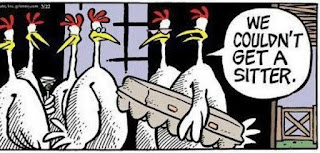Why did the chicken cross the road? Maybe to get to a lighthouse!
Almost every lighthouse in the world, even those in cramped, distant, and wild places, had a chicken coop of some sort. Lighthouse keepers wanted to have some degree of self-sufficiency, so raising chickens for meat and eggs was a good option.
 |
| Helgoland Lighthouse in Germany is shown on this old postcard with a chicken coop, a chicken yard, and a pretty flock of white free-ranging chickens. |
 |
| This bucolic image of Tarpaulin Cove Lighthouse in Massachusetts shows a small flock of chickens scratching around on the lawn. |
My Facebook friend and lightkeeper's daughter, Seamond Roberts, remembers her mother's chickens in the 1940s at Cuttyhunk Lighthouse on an offshore island of Massachusetts. Pictured is Cuttyhunk Light and an image of the family's chicken coop, courtesy of Seamond Roberts. The chickens were beloved pets, in addition to providing food for the family.
Connie Small, wife of Maine lightkeeper Elson Small, wrote a book of her memories of life on the lighthouses. I interviewed her several times and photographed the memorabilia she had from her years on the lights. She kept chickens at almost every lighthouse where her husband was assigned, including St. Croix Island and Seguin Island. She is pictured below feeding her chickens at St. Croix Island in 1946. They had a sturdy coop--a necessity in Northern Maine where winters are harsh and long.
 |
| During Maine's long, cold winters, Connie quilted. Here's a scene from one of her quilts showing the chicken coop and a hen racing across the yard |
Even if lighthouse keepers were assigned to an offshore lighthouse, they found ways to rig up a small coop for a few hens. I think we can all agree; chickens are pretty easy to keep and they provide a steady supply of breakfasts and dinners!
The image above of Keeper Yeatman and his kids at Drum Point Lighthouse in the Chesapeake Bay has a chicken shown, in front of the keeper's right foot. Cluck! It's possible the Yeatman family kept chickens ashore in a small coop and let them free range on land in the daytime. Note the ladder and narrow walkway the family used to get to the shore. (Some would say the lighthouse itself resembles a large chicken coop!) I'm guessing one of the chores assigned to those kids was going ashore every day to feed the chickens and collect the eggs.
If a family assigned to a waterbound lighthouse couldn't keep chickens close by on shore, they could house them in a small coop on the under-pinnings of the lighthouse. Notice the various boxes and containers stowed beneath the lighthouses in the pictures below. Some of the objects are water tanks and storage containers, but there also might be a small chicken coop tucked in the iron legs for two or three hens .
Modern woman I am, I don't have much in common with lighthouse keepers. I live a pampered life, get my provisions easily from a grocery store, live in a spacious and comfortable house near to civilization, and don't do much physical work. But I do keep chickens. They make my breakfast every morning and remind me of my childhood and helping care for my mother's big flock of Plymouth White Rocks. I have such great memories of those experiences (including one very ornery rooster named Putter!) that I set them down in an eBook a few years ago titled The Funky Chicken: Memories, Truth & Tribute. You can find it on Amazon.
My hens are various breeds, including Barred Rocks, Australorps, Wyandottes, Sex-Links, and Rhode Island Reds (my favorites). Having chickens is about my only link to lighthouse keeping beyond all the research, speaking, and writing I do about lighthouse. But...if I was a lighthouse keeper...you can bet I'd have a very large flock!
 |
| Circe, the Little Red Hen, is my favorite. I'm holding a piece of cantaloupe rind she cleaned completely of its fruit until it was barely an eighth of an inch thick. Somehow she got it over her head and wore it like a necklace. She's our comic chicken! Circe is six now, getting old for a hen, but she still lays eggs and likes to be petted. |
All b&w images, where not otherwise noted, are from the collection of the U.S. Coast Guard Historian.














No comments:
Post a Comment
I welcome your comments, photos, stories, etc.!